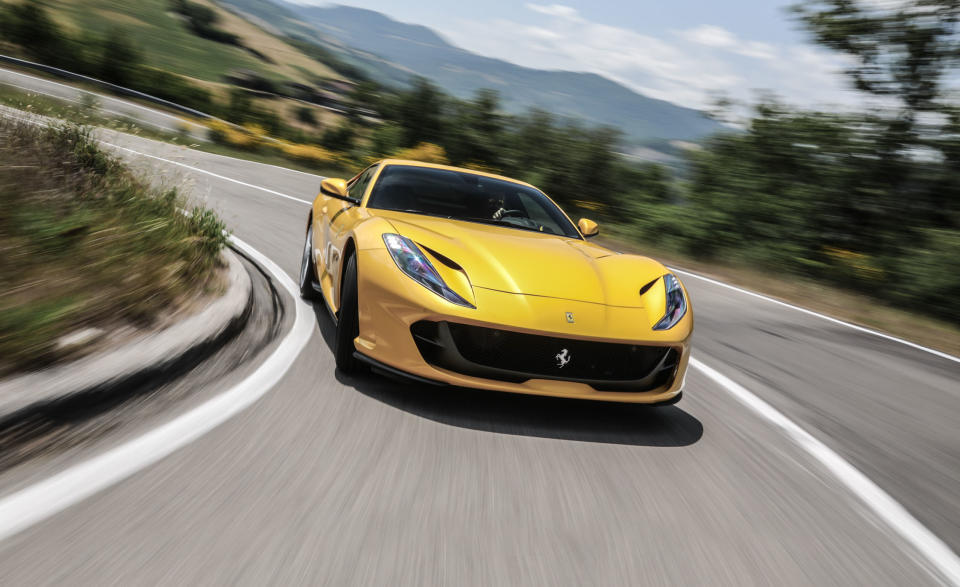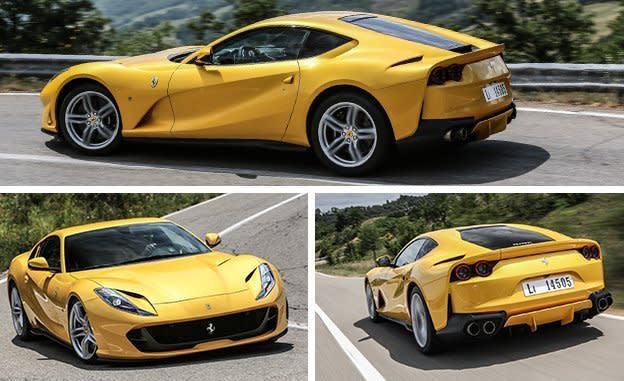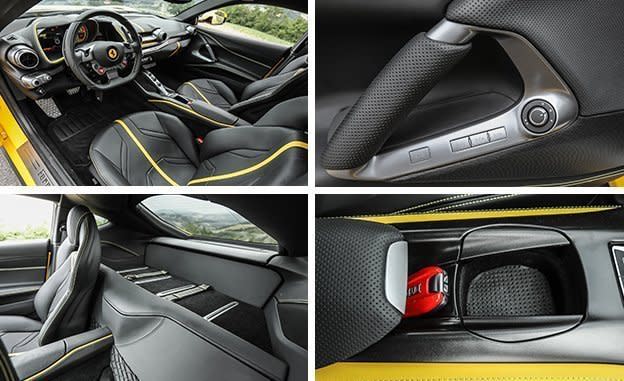2018 Ferrari 812 Superfast

On one recent Saturday, I jumped out of an airplane. But that wasn’t the most exciting thing that happened that week. Because six days later, I drove the Ferrari 812 Superfast. In Italy, on Ferrari’s private race/test track in Fiorano. It was, in skydiver parlance, epic. The speeds were higher, the g loads greater, and the soundtrack light-years better than just a whole lot of high-speed wind buffeting past my ears.
The 8 in this car’s name denotes the 800 horsepower the engine generates on the European scale. As measured on this side of the Atlantic, though, it’s a mere 789, an extra 59 over the F12berlinetta that this model replaces. The 12 is on the badge because there are a dozen cylinders beneath the hood, and Superfast is both a name from Ferrari’s history and a promise delivered.

Compared with the F12’s engine, the 812’s is 75 percent new. Displacing 6.5 liters versus the F12’s 6.3, the 12 makes its 789 horsepower at 8500 rpm on its way to an 8900-rpm redline. Peak torque, 530 lb-ft, crests at 7000. Below 5000 rpm, the 812 is a pussycat, but as the revs rise, the power seems to build exponentially. There is about 600 horsepower at 6000 rpm, 700 at 7000, and as the tach winds up, the compounding sensation of acceleration is stupefying. The engine revs so far past the initiation of insanity that each redline upshift is almost a relief. Expect the zero-to-60-mph sprint to be over in just 2.8 seconds and the quarter-mile to pass in 10.8 ticks or so. And then there’s the sound. It’s your very own Formula 1 fantasy, heaven’s own chain saw.
Agile? Must Be Italian
The handling, too, is something out of a fantasy. Ferrari’s first ever electrically assisted power-steering system directs the 812, and it’s a solid effort. As we trundled through the streets of Maranello just outside the factory gates, it felt maybe a touch overboosted. But once the town gave way to hills and fields, we realized that the steering matches the feeling of the entire car. Agility we expected, but the whole car feels unbelievably light, like the world’s most furious Mazda Miata. Here is a 3900-pound car with a giant 6.5-liter engine in its nose, but it is unbelievably dextrous, like a V-12 wingsuit. The steering is immediate and effort builds faithfully, but there’s very little feedback from the road surface. Given how great the steering is in other respects, though, we’d give it just a couple of years before Ferrari perfects it, making access to the best steering on the planet another reason to resent the 1 percent.

The 812 carries over the structure from the F12—the wheelbase and the rear track are identical, and the only reason the front track is wider is because the tires are—which means nearly the whole car is constructed of aluminum. Carbon fiber is employed almost purely as a stylistic flourish, in most cases an optional one. The F12 TdF donates its rear-wheel-steering system.
As he took us on an orientation lap—a single one!—of Ferrari’s test track at Fiorano, development driver Raffaele de Simone made sure we knew how to turn off stability control and said, “It’s okay if you spin the car off the track.” Um, no, it isn’t, Raffaele. And yet, the rest of his advice proved well founded.

You expect an 800-hp, $300,000 megacar to be intimidating, but so controllable and predictable is the 812 that we were immediately comfortable. By the end of our second lap, stability control was turned off, the 812 was sideways, and we were giggling like a teenager doing our first burnout again. It feels as if the driver can transfer individual pounds of load to each wheel to balance the car through turns, and the linear power delivery means that you can meter precisely as many ponies as you need to maintain any intended line or slip angle. The F12 was among the quickest cars we’ve ever tested at Lightning Lap, and we suspect the 812 is going to take a bite off its predecessor’s 2:50.8 time around Virginia International Raceway’s Grand Course.
And Sensible, Too!
The spacious interior and comfortable driving position do much for the car’s approachability, as does the excellent visibility to the front and sides. The high tail means the view rearward is more like that of a mid-engined car. But even 99th-percentile drivers can get comfortable in the driver’s seat. While the ride is a little choppy, the suspension rounds the harsh edges off any bumps. This would make a perfectly acceptable daily driver.

In subdued colors, the 812 could almost come close to blending into traffic. Whether other commuters envy you will be a matter of taste. But there’s a load of function in the Superfast’s extreme styling, and every last intake and vent punched into the bodywork is functional. With about a dozen different passageways through the sheetmetal, air doesn’t just flow around the 812, it passes through it much like it slips through a skydiver’s fingers. And like a skydiver falling from an airplane, the Superfast driver will never be bored. He’ll also have something much better to listen to.
Specifications >
VEHICLE TYPE: front-engine, rear-wheel-drive, 2-passenger, 2-door hatchback
ESTIMATED BASE PRICE: $315,000
ENGINE TYPE: DOHC 48-valve V-12, aluminum block and heads, direct fuel injection
Displacement: 397 cu in, 6496 cc
Power: 789 hp @ 8500 rpm
Torque: 530 lb-ft @ 7000 rpm
TRANSMISSION: 7-speed automatic with manual shifting mode
DIMENSIONS:
Wheelbase: 107.1 in
Length: 183.3 in
Width: 77.6 in Height: 50.2 in
Cargo volume: 18 cu ft
Curb weight (C/D est): 3900 lb
PERFORMANCE (C/D EST):
Zero to 60 mph: 2.8 sec
Zero to 100 mph: 6.8 sec
Standing ¼-mile: 10.8 sec
Top speed: 211 mph
FUEL ECONOMY (C/D EST):
EPA combined/city/highway: 13/12/16 mpg

 Yahoo Autos
Yahoo Autos 